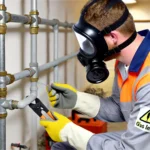- Introduction To Carrier Comfort Pro
- Why Regular Maintenance Is Crucial
- Key Maintenance Tasks For Carrier Comfort Pro
- Inspecting And Cleaning The Condenser Coils
- Lubricating Moving Parts
- Best Practices For Lubrication
- Checking The Refrigerant Levels
- How To Recharge The Refrigerant
- Inspecting Electrical Connections
- How To Check And Tighten Electrical Connections
- Seasonal Maintenance Tips
- Diy Maintenance Vs. Professional Service
- Common Issues And Troubleshooting
- Maintenance Schedule And Checklist
- Printable Checklist For Carrier Comfort Pro Maintenance
- Upgrading And Replacing Parts
- Steps To Safely Replace Or Upgrade Parts
- Energy-saving Tips For Carrier Comfort Pro
- Conclusion
Introduction To Carrier Comfort Pro
Carrier Comfort Pro is a reliable and efficient heating and cooling system used in many homes and businesses. It is designed to provide comfort in both summer and winter. This system is known for its durability and high performance. It helps maintain the desired temperature inside the building, making it a popular choice for those who want consistent and dependable climate control. Whether you’re dealing with extreme heat or bitter cold, Carrier Comfort Pro can keep your space comfortable throughout the year.
Regular maintenance is vital to ensure that Carrier Comfort Pro operates at its best. By keeping the system in good shape, you can extend its lifespan and avoid unexpected breakdowns. Regular maintenance helps the system run more efficiently, which can save on energy costs. It also reduces the risk of major repairs by catching small issues before they become big problems. Maintaining Carrier Comfort Pro is not just about performance; it’s also about safety. Proper care ensures that the system runs safely, providing peace of mind for you and your family.
This system is an investment, and regular maintenance is the best way to protect that investment. Keeping it in top condition ensures that it will continue to deliver comfortable temperatures for many years to come.
Why Regular Maintenance Is Crucial
Extending the Lifespan of the Carrier Comfort Pro Unit
Regular maintenance is key to ensuring your Carrier Comfort Pro lasts as long as possible. Without proper care, the system can wear out faster, leading to an early replacement. By regularly checking and servicing the unit, you can prevent small issues from turning into bigger problems that could shorten its lifespan. A well-maintained Carrier Comfort Pro can serve you for many years, providing consistent comfort and reliability.
Improving Efficiency and Reducing Energy Consumption
A properly maintained Carrier Comfort Pro operates more efficiently. When the system is clean and all parts are functioning correctly, it uses less energy to maintain the desired temperature. This not only lowers your energy bills but also reduces the overall strain on the unit. Over time, even small improvements in efficiency can lead to significant savings. Regular maintenance helps keep the system running at its best, ensuring you get the most out of your investment.
Preventing Costly Repairs and Breakdowns
Neglecting regular maintenance can lead to unexpected and expensive repairs. Small issues, if left unattended, can turn into major breakdowns that require costly fixes. Regular check-ups allow you to catch these problems early, often before they become serious. By keeping up with maintenance, you can avoid the stress and expense of sudden system failures. It’s much easier and cheaper to maintain the Carrier Comfort Pro than to deal with a major repair or replacement.
Regular maintenance of the Carrier Comfort Pro is crucial for keeping the system running smoothly, efficiently, and for as long as possible.
Key Maintenance Tasks For Carrier Comfort Pro
Checking And Replacing Filters
How Often Should Filters Be Replaced?
Replacing the filters regularly is essential for keeping the Carrier Comfort Pro running efficiently. Filters should be checked at least once a month, especially during peak usage seasons like summer and winter. If the filter appears dirty or clogged, it should be replaced immediately. Generally, filters need replacement every 1 to 3 months, depending on usage and air quality.
Step-by-Step Guide to Replacing Filters
- Turn off the Carrier Comfort Pro unit to ensure safety.
- Locate the filter compartment, usually found near the return air duct.
- Open the compartment and carefully remove the old filter.
- Check the size and type of the filter to ensure you have the correct replacement.
- Insert the new filter with the airflow arrows pointing in the correct direction.
- Close the compartment securely and turn the unit back on.
Inspecting And Cleaning The Condenser Coils
Importance of Keeping Condenser Coils Clean
The condenser coils play a vital role in the cooling process by releasing heat from the system. If the coils become dirty or clogged, the unit has to work harder, reducing efficiency and increasing energy consumption. Regular cleaning of the condenser coils helps maintain optimal performance.
How To Safely Clean The Condenser Coils
- Turn off the power to the unit to prevent any electrical hazards.
- Remove any debris or dirt from around the condenser unit.
- Use a soft brush or vacuum to gently clean the surface of the coils.
- For deeper cleaning, use a coil cleaner spray designed for HVAC systems.
- Rinse the coils with a gentle stream of water, being careful not to bend the fins.
- Allow the coils to dry completely before turning the unit back on.
Lubricating Moving Parts
Importance Of Keeping Condenser Coils Clean
The condenser coils play a vital role in the cooling process by releasing heat from the system. If the coils become dirty or clogged, the unit has to work harder, reducing efficiency and increasing energy consumption. Regular cleaning of the condenser coils helps maintain optimal performance.
Best Practices For Lubrication
- Turn off the unit before beginning any maintenance.
- Identify the moving parts that need lubrication, typically noted in the owner’s manual.
- Use the recommended lubricant for HVAC systems, and apply it sparingly to avoid over-lubrication.
- Wipe away any excess lubricant to prevent it from attracting dirt and debris.
- Turn the unit back on and listen for any unusual noises that may indicate further lubrication is needed.
Checking The Refrigerant Levels
Signs of Low Refrigerant Levels
Low refrigerant levels can cause the Carrier Comfort Pro to cool less effectively and may lead to higher energy bills. Signs of low refrigerant include reduced cooling capacity, ice buildup on the evaporator coils, and a hissing sound from the unit.
How To Recharge The Refrigerant
- Turn off the system and locate the refrigerant lines.
- Attach a pressure gauge to the service valve to check the current refrigerant level.
- If the refrigerant is low, connect the refrigerant tank to the service valve.
- Slowly add refrigerant to the system, monitoring the pressure gauge closely.
- Once the correct level is reached, disconnect the tank and close the service valve.
- Turn the unit back on and check for proper cooling performance.
Inspecting Electrical Connections
Importance Of Secure Electrical Connections
Loose or damaged electrical connections can lead to malfunctions or even pose a safety risk. Regular inspection ensures that all connections are secure and functioning properly, preventing potential issues.
How To Check And Tighten Electrical Connections
- Turn off the power to the unit before starting any electrical work.
- Open the access panel to reveal the electrical connections.
- Inspect all connections for signs of wear, corrosion, or looseness.
- Use a screwdriver to tighten any loose connections, but be careful not to over-tighten.
- Replace any damaged wires or connectors.
- Close the access panel and restore power to the unit.
By following these key maintenance tasks, you can ensure that your Carrier Comfort Pro operates efficiently, lasts longer, and avoids costly repairs.
Seasonal Maintenance Tips
Preparing Carrier Comfort Pro for Summer Use
As the summer approaches, it’s important to ensure that your Carrier Comfort Pro is ready to handle the increased cooling demands. Start by cleaning or replacing the filters to allow for better airflow. Check the condenser coils to ensure they are free of dirt and debris, which can reduce the unit’s efficiency. Make sure the refrigerant levels are adequate to avoid strain on the system. Finally, inspect the thermostat settings to ensure they are calibrated correctly for energy-efficient cooling. Proper preparation helps the unit run smoothly during the hottest months, keeping your space comfortable.
Winterizing Your Carrier Comfort Pro Unit
When the colder months arrive, it’s essential to prepare your Carrier Comfort Pro for winter. Begin by cleaning the unit thoroughly, including the condenser coils and filters. This helps prevent dirt and debris from causing damage during the off-season. Consider covering the outdoor unit with a breathable cover to protect it from snow, ice, and debris. Additionally, if your Carrier Comfort Pro includes a heating function, make sure to inspect and test the heating elements to ensure they are working correctly. Proper winterization protects the system from the harsh winter conditions and prolongs its lifespan
Tips for Off-Season Storage
During periods of non-use, proper storage of your Carrier Comfort Pro is crucial. Start by cleaning the entire unit, including filters, coils, and moving parts. Disconnect the power supply to prevent any accidental start-up or electrical issues. If possible, store the unit in a dry, sheltered location to protect it from the elements. If the unit must remain outside, use a weatherproof cover to shield it from rain, snow, and dust. Regularly check on the unit during the off-season to ensure it remains in good condition, so it’s ready to perform when you need it again..
Following these seasonal maintenance tips ensures that your Carrier Comfort Pro remains in top condition throughout the year, providing reliable comfort in every season.
Diy Maintenance Vs. Professional Service
What Maintenance Tasks You Can Do Yourself
There are several maintenance tasks you can handle on your own to keep your Carrier Comfort Pro in good shape. These include regularly checking and replacing the filters, cleaning the condenser coils, and lubricating the moving parts. You can also inspect the electrical connections to ensure they are secure and check the refrigerant levels for any signs of low refrigerant. These simple tasks help maintain the efficiency of the unit and prevent minor issues from escalating.
When to Call a Professional Technician
While some tasks are easy to do yourself, there are times when it’s best to call a professional. If you notice unusual noises, inconsistent cooling or heating, or frequent breakdowns, it’s time to contact a technician. Complex issues like refrigerant leaks, electrical problems, or major repairs require the expertise of a professional. Additionally, an annual professional inspection is recommended to catch any potential problems that might not be visible to the untrained eye.
Benefits of Regular Professional Servicing
Regular professional servicing offers several advantages. Technicians have the skills and tools to perform a thorough inspection and can identify issues early, preventing costly repairs down the line. They also ensure that the unit is operating at peak efficiency, which can lower your energy bills. Moreover, regular professional maintenance helps extend the lifespan of the Carrier Comfort Pro, ensuring that it continues to provide reliable comfort for years to come. By combining DIY maintenance with professional servicing, you can keep your system in top condition and avoid unexpected breakdowns.
Balancing DIY maintenance with regular professional servicing is the best way to ensure your Carrier Comfort Pro runs efficiently and reliably throughout its life.
Common Issues And Troubleshooting
Identifying Common Problems With Carrier Comfort Pro
Even with regular maintenance, the Carrier Comfort Pro may encounter some common issues. These include reduced cooling or heating efficiency, unusual noises, and frequent cycling on and off. Other problems might include poor airflow, water leaks, and the system not turning on at all. Identifying these issues early can prevent more serious problems from developing and ensure your unit continues to operate smoothly.
Troubleshooting Tips For Common Issues
For many of these common issues, there are simple troubleshooting steps you can take. If the cooling or heating efficiency is reduced, check and replace the filters, as clogged filters can block airflow. If you hear unusual noises, inspect the fan blades and moving parts for any debris or signs of wear and tear. For poor airflow, ensure that the vents are not blocked and that the condenser coils are clean. If the unit is cycling on and off frequently, check the thermostat settings and ensure the refrigerant levels are correct. Addressing these issues promptly can often resolve the problem without the need for professional intervention
When To Seek Professional Help For Complex Problems
Some issues with the Carrier Comfort Pro require professional expertise. If you experience persistent problems despite troubleshooting, such as ongoing refrigerant leaks, electrical issues, or the system not starting at all, it’s time to call a technician. These complex problems can lead to more serious damage if not addressed properly. A professional will have the tools and knowledge to diagnose and fix these issues, ensuring the long-term health of your system. Regular maintenance checks by a professional can also help catch these problems before they become major concerns.
By understanding and addressing common issues with the Carrier Comfort Pro, you can keep your system running smoothly and avoid more serious repairs. However, knowing when to seek professional help is key to maintaining the longevity and efficiency of your unit..
Maintenance Schedule And Checklist
Suggested Maintenance Schedule (Weekly, Monthly, Yearly Tasks)
To keep your Carrier Comfort Pro running efficiently, it’s important to follow a regular maintenance schedule. Here’s a suggested timeline:
Weekly Tasks:
- Check the filters: Inspect the filters for dust and debris. If they appear dirty, consider cleaning or replacing them.
- Visual inspection: Perform a quick visual check of the unit for any signs of wear, damage, or debris around the outdoor unit.
Monthly Tasks:
- Replace the filters: Change the filters if they are dirty. Regular replacement ensures proper airflow and efficiency.
- Clean the condenser coils: Inspect and clean the condenser coils to remove any dirt or buildup.
- Check for unusual noises: Listen for any unusual sounds during operation, which could indicate a problem with the moving parts or electrical components.
Yearly Tasks:
- Full system inspection: Schedule a professional inspection of the entire system to check for any issues and perform in-depth maintenance.
- Lubricate moving parts: Ensure all moving parts, such as motors and fans, are properly lubricated to reduce friction and wear.
- Check refrigerant levels: Have a professional check the refrigerant levels to ensure optimal cooling performance.
- Inspect electrical connections: Make sure all electrical connections are secure and functioning correctly to avoid any potential hazards.
- Test thermostat settings: Calibrate the thermostat to ensure it’s reading temperatures accurately and set for energy efficiency.
Printable Checklist For Carrier Comfort Pro Maintenance
Creating a printable checklist can help you stay on top of these tasks. Here’s a simple checklist you can print out and use:
Carrier Comfort Pro Maintenance Checklist
Weekly Tasks:
- Check filters for dust and debris
- Perform a visual inspection of the unit
Monthly Tasks:
- Replace filters
- Clean condenser coils
- Check for unusual noises
Yearly Tasks:
- Schedule a full system inspection with a professional
- Lubricate moving parts
- Check refrigerant levels
- Inspect electrical connections
- Test and calibrate thermostat settings
This checklist ensures that you perform regular maintenance on your Carrier Comfort Pro, helping to extend its lifespan, improve efficiency, and prevent unexpected breakdowns. Keeping up with this schedule will keep your unit in top condition year-round.
Upgrading And Replacing Parts
When To Consider Upgrading Parts
Upgrading parts of your Carrier Comfort Pro may be necessary if you notice a decline in performance, increased energy bills, or frequent breakdowns. If your system is older, newer parts can enhance efficiency and extend its lifespan. Additionally, upgrading to more advanced components, like a smart thermostat or energy-efficient fans, can improve the overall performance and reduce operating costs. Consider upgrading parts when regular maintenance no longer seems to improve the unit’s efficiency or when a professional technician recommends it during an annual inspection.
Sourcing And Purchasing Genuine Carrier Comfort Pro Parts
When replacing or upgrading parts, it’s important to use genuine Carrier Comfort Pro parts. Using authentic parts ensures compatibility with your system, maintains its efficiency, and preserves any existing warranties. You can source these parts from authorized Carrier dealers, HVAC supply stores, or directly from the Carrier website. Be cautious of third-party sellers, as counterfeit or non-genuine parts may not meet the required specifications and could lead to further issues. Always verify the authenticity of the parts before purchasing
Steps To Safely Replace Or Upgrade Parts
- Turn Off the Power: Before starting any work, ensure the power to the unit is completely turned off to avoid electrical hazards.
- Identify the Part: Locate the part that needs to be replaced or upgraded, referring to the owner’s manual for guidance.
- Remove the Old Part: Carefully disconnect and remove the old part, making sure to keep any screws or clips that may be needed for the new installation.
- Install the New Part: Position the new part in place and secure it with the necessary screws or clips. Ensure all connections are tight and properly aligned.
- Reconnect and Test: After installing the new part, reconnect any wires or components that were disconnected. Turn the power back on and test the system to ensure the part is functioning correctly.
- Check for Issues: Monitor the unit for a while after the replacement to ensure everything is running smoothly and efficiently.
Upgrading and replacing parts with genuine Carrier Comfort Pro components ensures your system continues to operate at peak performance. Always follow safety guidelines and consider consulting a professional if you’re unsure about the process.
Energy-saving Tips For Carrier Comfort Pro
Adjusting Settings For Maximum Efficiency
Optimizing the settings on your Carrier Comfort Pro can significantly improve its efficiency and reduce energy consumption. Start by setting the thermostat to a comfortable yet energy-efficient temperature, such as 78°F in the summer and 68°F in the winter. Consider using a programmable or smart thermostat to automatically adjust the temperature when you’re away or sleeping. Ensure the fan is set to “Auto” rather than “On” to prevent it from running continuously, which can waste energy. By fine-tuning these settings, you can maintain comfort while using less energy
Tips For Reducing Energy Consumption
There are several strategies you can use to lower your energy consumption with the Carrier Comfort Pro. Keep the filters clean and replace them regularly to ensure proper airflow, which helps the system run more efficiently. Make sure the area around the outdoor unit is clear of debris and vegetation to allow for optimal air circulation. During the hottest or coldest days, close blinds or curtains to reduce the load on your system. Additionally, avoid using heat-producing appliances like ovens or dryers during the hottest part of the day. Implementing these simple tips can help you save energy and reduce your utility bills…
How Regular Maintenance Contributes To Energy Savings
Regular maintenance is crucial for keeping your Carrier Comfort Pro operating at peak efficiency, which directly impacts energy savings. Clean filters, well-lubricated moving parts, and properly maintained condenser coils ensure that the system doesn’t have to work harder than necessary to maintain the desired temperature. Regular checks on refrigerant levels and electrical connections also prevent issues that could lead to increased energy consumption. By investing in routine maintenance, you not only extend the lifespan of your unit but also keep your energy costs down by ensuring the system runs as efficiently as possible.
Following these energy-saving tips for your Carrier Comfort Pro can help you maintain a comfortable indoor environment while keeping your energy usage in check. Regular maintenance and smart adjustments to your system settings are key to maximizing efficiency and minimizing energy waste.
Conclusion
In conclusion, regular maintenance of your Carrier Comfort Pro is essential for ensuring optimal performance, extending its lifespan, and preventing costly repairs. By following a consistent maintenance routine, you can keep the system running efficiently and comfortably, while also saving on energy costs. Remember to check and replace filters, clean the condenser coils, and schedule professional inspections as needed. With these practices in place, you can enjoy the long-term reliability of your Carrier Comfort Pro, ensuring that it continues to provide the comfort you need throughout the year.
Frequently Asked Questions (FAQs)
How Often should I service My Carrier Comfort Pro?
It is recommended to service your Carrier Comfort Pro at least once a year. This annual maintenance ensures that the system is operating efficiently and can help identify any potential issues before they become serious problems. Additionally, checking the filters and performing basic maintenance tasks like cleaning the condenser coils should be done monthly, especially during peak usage seasons.
What Are The Signs That My Carrier Comfort Pro needs Maintenance?
Several signs indicate that your Carrier Comfort Pro may need maintenance. Look for reduced cooling or heating efficiency, unusual noises, or frequent cycling on and off. You may also notice higher energy bills or water leaks around the unit. If the thermostat is not responding correctly or you see ice buildup on the coils, it’s a good idea to schedule maintenance
Can I perform Carrier Comfort Pro maintenance Myself, Or Should I hire A Professional?
You can perform basic maintenance tasks, such as checking and replacing filters, cleaning the condenser coils, and lubricating moving parts. However, for more complex tasks, such as checking refrigerant levels or electrical connections, it is best to hire a professional technician. Regular professional servicing ensures that your system remains in top condition and helps catch any issues that may not be visible during DIY maintenance
Thank you for visiting our Blog! For more engaging content, please check out the related category.





